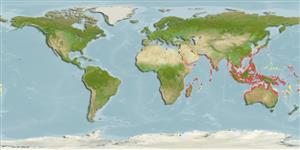Common names from other countries
Environment: milieu / climate zone / depth range / distribution range
นิเวศวิทยา
เกี่ยวกับทะเล,น้ำเค็ม; กร่อย กลุ่มสัตว์หน้าดิน,กลุ่มสัตว์พื้นท้องน้ำ. Tropical; 35°N - 37°S, 20°E - 178°W
Indo-Pacific: Persian Gulf to Fiji and north to Japan. Known from Delagoa Bay, Mozambique and Suez Canal on the African coast. Western Atlantic: introduced at Trinidad and Panama Canal near Atlantic end (Ref. 26938).
ขนาด / น้ำหนัก / Age
Maturity: Lm ? range ? - ? cm
Max length : 9.5 cm SL เพศผู้/กระเทย; (Ref. 4404); อายุสูงสุดที่ได้รายงาน: 4 ปี (Ref. 11441)
เงี่ยงครีบหลัง (รวม) : 11 - 13; ก้านครีบอ่อนที่หาง (รวม) : 19 - 24; เงี่ยงครีบก้น: 2; ก้านครีบอ่อนที่ก้น: 20 - 26. Head without cirri and crest. Lower end of gill opening opposite upper margin of pectoral fin. Sensory pores in infraorbital and interorbital canals mostly 8 and 3 respectively. Lateral line usually 7 to 11. Horizontal stripes on body distinct in male, but somewhat obscure in female.
Adults occur in coastal and brackish waters among rocks and mangroves (Ref. 9710). Oviparous. Eggs are demersal and adhesive (Ref. 205), and are attached to the substrate via a filamentous, adhesive pad or pedestal (Ref. 94114). Larvae are planktonic, often found in shallow, coastal waters (Ref. 94114). Highly tolerant to adverse environmental conditions, self-reproducing population living between rocks in natural oil seeps in Venezuela (Ref. 56126).
Life cycle and mating behavior
Maturities | การสืบพันธุ์ | Spawnings | Egg(s) | Fecundities | ตัวอ่อน
Oviparous, distinct pairing (Ref. 205).
Springer, V.G., 1986. Blenniidae. p. 742-755. In M.M. Smith and P.C. Heemstra (eds.) Smiths' sea fishes. Springer-Verlag, Berlin. (Ref. 4404)
IUCN Red List Status (Ref. 130435)
CITES (Ref. 128078)
Not Evaluated
Threat to humans
Harmless
Human uses
การประมง: ไม่มีผลประโยชน์
เครื่องมือ
Special reports
Download XML
แหล่งที่มาจากอินเตอร์เน็ต
Estimates based on models
Preferred temperature (Ref.
115969): 24.7 - 29.1, mean 28.4 (based on 2724 cells).
Phylogenetic diversity index (Ref.
82804): PD
50 = 0.5000 [Uniqueness, from 0.5 = low to 2.0 = high].
Bayesian length-weight: a=0.00741 (0.00410 - 0.01339), b=3.09 (2.92 - 3.26), in cm Total Length, based on LWR estimates for this species & (Sub)family-body (Ref.
93245).
ระดับชั้นอาหาร (Ref.
69278): 2.5 ±0.1 se; based on size and trophs of closest relatives
ความสามารถในการกลับคืนสู่ปกติ (Ref.
120179): ขนาดกลาง, เวลาต่ำสุดที่จะทำให้ประชากรเพิ่มขึ้นเป็น 2 เท่าใช้เวลา 1.4 - 4.4 ปี (tmax=4).
Fishing Vulnerability (Ref.
59153): Low vulnerability (10 of 100).
